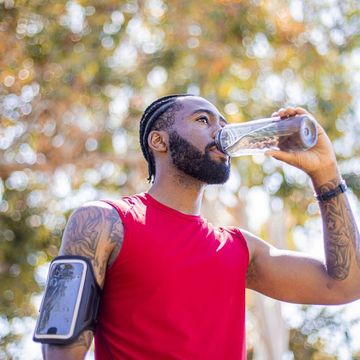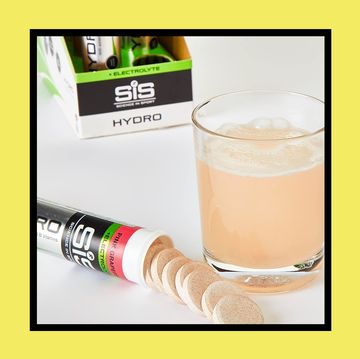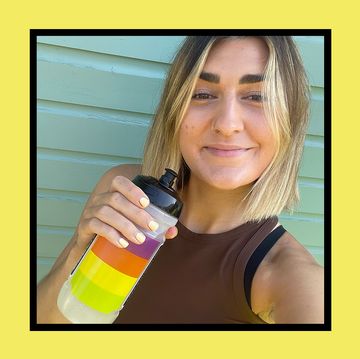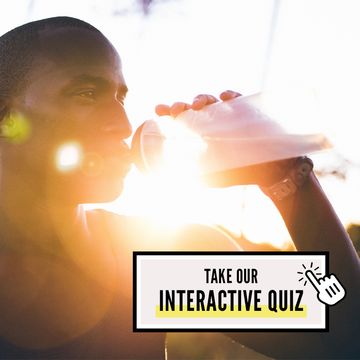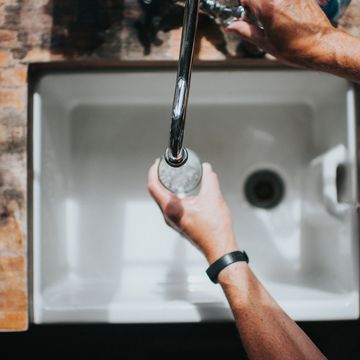Have you ever finished a run and noticed a thin layer of salt built up on your arms or forehead? This is evidence of your body losing salt – or electrolytes – through sweat. Keeping on top of your electrolyte levels (through food or the best electrolyte drinks, powders and tablets) is super important for your running performance, whether you’re in training or gunning for a PB on race day.
‘Just a 2% loss in body weight due to dehydration can impair exercise performance,’ says leading sports dietitian Renee McGregor. ‘It’s well documented in research that fluid intake and adequate hydration during exercise are essential, especially during prolonged training sessions and competition events.
‘The key role of fluid intake during running is maintaining hydration, body temperature and adequate plasma (blood) volume.’
So, what are electrolytes?
Electrolytes are essential minerals (including sodium) that the body needs to stay hydrated. However, their role extends further – they also support important processes within the body including muscle contraction, blood pressure and nerve signalling, to name a few.
Electrolytes help your body retain fluid during heavy exercise when you are sweating as they help draw fluid into working muscles.
What happens when your body is low on electrolytes?
Ensuring your plasma volume and body temperature stay within an optimal range has a direct impact on performance, says McGregor. When your core temperature rises due to dehydration, plasma volume decreases, resulting in an increased heart rate, which in turn accelerates fatigue.
Dehydration also has an effect on cognitive function, resulting in an inability to think clearly. The main symptoms of low sodium intake and dehydration include gastrointestinal distress, nausea, bloating, fatigue, impaired concentration and dizziness.
How to replace electrolytes
When it comes to replacing lost electrolytes, there are various options – electrolyte drinks, electrolyte tablets for dissolving in water and salt capsules/sticks that can be taken directly. They’re often added in varying quantities to sports drinks too.
‘Most electrolyte tablets, salt capsules or sports drinks provide around 250-300mg of sodium per serving,’ says McGregor.
But some sports nutrition companies have realised the importance of salt, especially in long-distance events, and have formulated electrolyte drinks, powders and tablets with higher sodium content. These include products from the likes of Precision Hydration.
In addition, it’s also possible to use real food in ultra-distance races. Some suggestions include:
- Salted peanuts
- Mashed potato with cheese or Marmite
- Cheese straws
- Jerky
How many electrolytes do you need?
Most runners sweat between 400 to 2,400ml per hour of exercise, with the average value being around 1,200ml per hour. However, this will vary with age, sex, weight, exercise intensity and environmental temperature.
The sodium content of sweat also varies substantially, from 115mg to greater than 2,000mg per litre of sweat. ‘But a runner who is a “salty sweater” (i.e. has a high amount of sodium in their sweat) may lose well in excess of the recommended intakes,’ says McGregor.
'A sweat test is the easiest way to work out exactly how much sodium you're losing when you sweat, but as a rule of thumb, I generally suggest runners take around 700 to 900mg of sodium per 1,000ml of fluid during longer training and competition,’ says McGregor. ‘This can be a mix of electrolyte tablets, electrolyte powder, energy drinks and whole food.’
Be mindful of the formula you're taking, though. 'The problem when you take diluted [electrolytes] is that if you don’t drink as much, then you don’t get as much electrolyte. So I like to take chewable ones so I know I’m getting 300mg every hour or whatever it is I need.'
Another thing to note is that women in the luteal phase of their menstrual cycle will probably have higher sodium loses. 'This is because core temperature increases so our sweat rates go up,' says McGregor. 'There is some evidence that we do loose more salt during that phase in our cycle too.'
When to take electrolytes
A lot of the time, whether or not you need to take electrolytes depends on the temperature and what you're doing (i.e. a 5k vs a marathon), says McGregor. The warmer it is, the more you'll sweat and the more sodium you'll lose.
Before the run
It can be equally important to think about electrolytes leading up to an event. McGregor says she regularly recommends that individuals start drinking them in the 24 hours prior to race day. Though, for a shorter run – less than two hours – 'you probably don't need to do that,' she adds.
'When you start doing three, four or five hours plus, you need to think about your hydration'.
During the run
As mentioned previously, during a long run or a race, McGregor suggests consuming around 700-900mg electrolytes per litre of fluid. 'So 350mg sodium in a 500ml bottle is a good place to start,' she says. 'Then you can look at your symptoms and how you’re feeling.'
After the run
Replacing electrolytes post-run or race is also important. ‘One of the best options is cow’s milk, as this not only replaces fluid but also has carbohydrate and protein in the right ratio to encourage recovery, while also being rich in electrolytes,’ says McGregor.
..

Renee is a leading Sports dietitian, specialising in Eating Disorders, REDs, The Female Athlete, Athlete health and performance.


